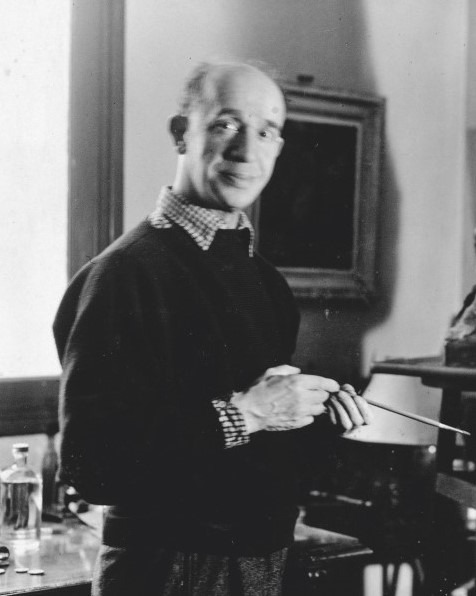Michel KIKOÏNE
January 2, 2019Isis KISCHKA
January 2, 2019Jésékiel KIRSZENBAUM
STASZOW (POLAND) 1900 – PARIS 1954
Kirszenbaum was born in Poland into a religious family. Already as a child, he spent his time drawing and painting. When he was twelve years old, people already called him “the Artist” and he started to design shop signs. Kirszenbaum arrived in Berlin in 1920. He continued to paint and taught Hebrew in order to earn a living. He was attracted by Paul Klee’s and Wassily Kandinsky’s fame, and went to Weimar in 1923. He studied at the Bauhaus for three semesters, and then returned to Berlin. For a few years, he worked as an illustrator and signed his work with the pseudonym Duvtivani. His dream came true in 1933, when he arrived in Paris and devoted himself to painting. Kirszenbaum produced oil paintings and watercolors inspired by Biblical scenes and life in the shtetl.
When World War II broke out, Kirszenbaum got away from the Nazis, but his wife was deported. “Since then, my life has been painful and bitter. I am not a saint, I no longer have any trust in mankind or in my own life…” His works prior to 1940 were destroyed. In 1948, he went to Brazil where he met his sister who had survived concentration camps and he participated in several exhibitions. He was desperate to return to France, for which he was tremendously nostalgic. “For people like us whose spirit is particularly sensitive, it is only in Paris and in France that the saddest loneliness still participates in the imperishable symphony of spirits …” Back in Paris in 1949, Kirszenbaum acquired French nationality. He met Baroness Alix de Rothschild, who was sensitive to art and appreciated his work. She took it upon herself to help him. He produced three monumental panels representing the prophets Elijah, Jeremiah, and Moses. He called her his “benefactress angel.” He illustrated books written by I.L. Peretz, a Yiddish writer whose stories revealed the essence of the Hassidic movement. In 1950 and 1951, he traveled to Morocco and Italy. Kirszenbaum died of cancer in 1954.
Stories of Jewish Artists of the School of Paris 1905-1939
FRENCH-ENGLISH
Capitale des arts, le Paris des années 1905-1939 attire les artistes du monde entier. De cette période de foisonnement, un terme est resté, celui d'Ecole de Paris, qui recouvre une grande diversité d'expression artistique. Dans ce brassage dont Montparnasse est le creuset, un groupe se distingue : celui des artistes juifs venus de Russie, de Pologne et d'Europe centrale. Si leurs styles sont variés, un destin commun les rassemble : ils fuient l'antisémitisme de leur pays d'origine. Certains ont connu la célébrité dès les années 1920, tels Soutine, Lipchitz ou Chagall. D'autres n'ont pas eu le temps ou la chance d'y accéder. Près de la moitié a péri dans les camps de concentration nazis.
From 1905 to 1939, Paris attracted artists from all over the globe as the capital of the art world. This period of artistic proliferation became known as the School of Paris, and includes a great diversity of artistic expression. Within the teeming art world centred on Montparnasse, one group set itself apart: Jewish artists from Russia, Poland, and Central Europe. Although their styles were diverse, they shared the common fate of fleeing anti-Semitic persecutions in their home countries. Some became famous in the 1920s, such as Soutine, Lipchitz, and Chagall, while others did not have the time or the luck to gain renown. Nearly half of these artists died in Nazi concentration camps.





